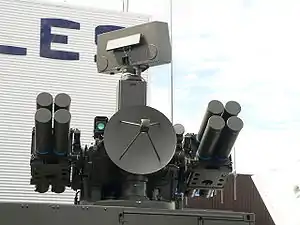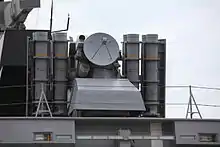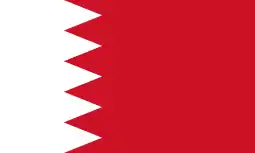Crotale (missile)
The Crotale EDIR (Ecartométrie Différentielle InfraRouge, "InfraRed Differential Ecartometry") is an all-weather short-range anti-air missile, which can be used to intercept low-flight anti-ship missiles and aircraft. It has been developed by Thomson CSF Matra and exists in two versions, a mobile land-based version and a ship-launched one.
| Crotale | |
|---|---|
 Crotale NG at the Paris Air Show, 2007 | |
| Type | Surface-to-air |
| Place of origin | France |
| Service history | |
| Used by | See Operators |
| Wars | Chadian-Libyan conflict Iran–Iraq War South African Border War |
| Production history | |
| Designed | 1952 |
| Manufacturer | Thales Group Samsung Group |
| Produced | 1954 |
| No. built | 6,000 missiles (R440) |
| Specifications | |
| Mass | 76 kg |
| Length | 2.35 m |
| Diameter | 0.165 m |
| Warhead weight | 13 kg |
Detonation mechanism | infrared fuse radio fuse |
| Engine | solid-propellant fuel |
Operational range | VT-1: 11 km Mk3: 16 km |
| Flight ceiling | VT-1: 6,000 m Mk3: 9,000 m |
| Maximum speed | 1,200 m/s |
Guidance system | semi-active radar homing electro-optical sensors Infra-red search and track |

Development
Originally the Crotale R440 system was developed by Rockwell International and Thomson-Houston (and Mistral) in France for South Africa, where it was named Cactus. However, the achievements of the system impressed the French Armed Forces, who purchased the system both for the air force and for the navy.
The firing system includes the main sensors of the ship, the firing system of the turret, and a central coordination system. The turret holds eight missiles ready for launch in watertight containers. The magazine behind the turret holds 18 missiles.
The French army first utilised a 4x4 wheeled vehicle, armed with four launchers. In order to ensure higher mobility, it was decided to mount the system on the chassis of the French AMX-30 main battle tank. At the same time, the number of launchers were increased to six. In Finnish Army service, the Crotale NG system has been mounted on Sisu Pasi vehicles. Here the number of launchers is eight.
The Crotale system has also been installed on various military ships. For instance the French Navy La Fayette class frigates have a Crotale 8-tubed launcher near the helicopter flight deck.
Crotale NG
A modernized version, the Crotale NG (New Generation), entered production in 1990. This version used the new VT-1 missile with Mach 3.5 speed, load factor to 35G, 11 km range, 13 kg warhead (8 m kill-zone) and 6,000 m ceiling. The system includes a S-band Pulse Doppler radar (20 km), Ku-band TWT tracking radar (30 km), Thermal camera (19 km), Daylight CCD camera (15 km), and an IR localiser.[1] An early '90s proposal to fit the system (in its eight-round form) to a Leclerc tank chassis in order to provide a battlefield air defence vehicle for protecting armored formations on the move was not realised due to post-Cold War cutbacks.
K-SAM Pegasus
In 1999, the Republic of Korea Armed Forces awarded a contract to Samsung Thales to jointly develop a South Korean-augmented Crotale NG system for the K-SAM Pegasus short range air defense system. A new sensor system was jointly developed by Samsung and Thales to meet the required operational capability of the upcoming K-SAM Pegasus,[2] as well as a new indigenous missile by LIG Nex1.[3] The electronics and radars were developed by Samsung Electronics.[4] Doosan DST integrated this modified Crotale NG system with a K200 vehicle. 48 units were initially produced for a price-tag of 330 million Euros.[5] A second batch of 66 units was ordered in 2003, valued at 470 million Euros.
Multi-Shield 100
Thales revealed an updated Crotale NG system with Shikra radar at the Paris Air Show in 2007.[6] The system combines Crotale Mk3 VT-1 missile and Shikra multi-beam search radar, with 150 km (detection range). Thales has demonstrated that the system's VT-1 missile has extended range to 15 km.[7]
Technology
The Crotale missile system consists of two components; a vehicle for transport, equipped with 2-8 launchers; a tracking radar is located between the launchers. A second vehicle carries the surveillance radar. The radar surveillance vehicle can be connected to several launcher vehicles, in order to achieve an effective air-defence system. The Crotale NG has incorporated both the launcher and the surveillance radar in one vehicle.
The missile is driven by solid-propellant fuel. It can reach its maximum speed of Mach 2.3 within only two seconds and then follows the radar beam, until its infrared fuze senses that it is near its target and explodes.
The surveillance radar and fire direction radar has a range of 20 km and the TV-link works up to 15 km. The TV-guidance system uses both regular and infrared cameras. The system can follow 8 targets simultaneously, and the guidance radar can follow both hovering helicopters as well as fighters exceeding speeds over Mach 2. The Crotale can also use surveillance data from other systems, data from optical surveillance and from the general aerial picture from the national air defence communications system.
Variants

- R440 Crotale
- The original Crotale SAM system, with both land and sea (Sea Crotale) systems. Over 330 systems and several thousand missiles were produced and exported to more than 15 countries.
- HQ-7
- China developed the HQ-7 system partly from reverse-engineering Crotale. An improved version, the HQ-7A/FM-90, is known to exist.
- Shahab Thaqeb & Herz-9
- In 2002 Iran revealed details concerning a domestically produced surface-to-air missile system, named Shahab Thaqeb. The system, mounted on a 4-wheel trailer, closely resemembled the Chinese HQ-7/FM-80/90 series which Iran had already received. It was unclear whether these systems were actually manufactured in Iran, or whether some portion of the assembly had been conducted domestically. The Ya Zahra air defense system was introduced in 2012. The Herz-9 is a self-propelled evolution of the Shahab Thaqeb system, domestically produced by Iran, utilizing a heavy 4X4 truck chassis. It was revealed by in May 2013. [8][9] [10]
- R460 SICA (Shahine)
- Thomson-CSF (now Thales) developed a specific version of the Crotale known as "Shahine" for Saudi Arabia. The system became operational in 1980. The main visible differences are mainly the carrier (an AMX 30 armoured carrier instead of the non protected classic carrier), and that it carries a six missile firing unit (instead of four). The purpose of the changes was to allow the Shahine firing and acquisition units to follow and protect the armoured units of the Saudi Armed Forces on the battlefield. The Shahine units were among the first vehicles to liberate Kuwait City in February 1991 – a picture taken of the scene was widely publicised by Newsweek magazine.
- Liberty Forward Area Air Defense System
- Developed in conjunction with LTV for the US Army's Line of Sight-Forward Heavy competition, the Liberty air defense system consisted of either 6 R460 SICA or 6 VT-1 missiles mounted on an M1A1 Abrams chassis along with a pair of 25mm cannons[11]
- Crotale NG (VT-1)
- An updated version, New Generation. Finland was the first operator of the system. The cost of the system is roughly 8 million euros (excluding the vehicle). Greece is another user, and paid 1 Billion French Francs in 1998 for 11 systems: 9 for the Hellenic Air Force and 2 for the Hellenic Navy. In 2002 euros, that would have amounted up to 12 million euros per unit.
- Crotale Mk.3 (system)
- In January 2008, France test-fired the new Crotale Mk.3 system at the CELM missile launch test center in Biscarrosse. The Crotale Mk.3 system's VT1 missile successfully intercepted a Banshee target drone at 970 metre altitude and 8 km range in 11 seconds on 15 January 2008. Later, on 31 January 2008, the system successfully intercepted another target drone at a 500-metre altitude and 15 km range in 35 seconds.[12]
Operators

Current operators
 Bahrain
Bahrain- Royal Bahraini Army
 Egypt
Egypt- Egyptian Army (test in 1976)
 Finland
Finland- The Finnish Army operates 21 Crotale NGs on Sisu XA-181 vehicles, designated ITO90M.
 France
France- naval Crotale and land-based Crotale NG (12 systems)
 Greece
Greece- Crotale NG, used by Hellenic Air Force (9 systems) and Hellenic Navy (2 naval systems).
 Iran
Iran- Ya Zahra air defense system is an unlicensed Iranian-copy of an unlicensed Chinese-copy of Crotale missiles.
 Oman
Oman- Crotale NG
 Pakistan
Pakistan- Pakistan Air Force[13]
 South Korea
South Korea- K-SAM Pegasus (114 systems)
 Saudi Arabia
Saudi Arabia- Shahine, Crotale[13]
 United Arab Emirates[13]
United Arab Emirates[13] Morocco
Morocco- Royal Moroccan Army[14]
Former operators
.svg.png.webp) Iraq
Iraq- Iraqi Air Force[16]
.svg.png.webp) Libya
Libya- [13] First delivery in 1973.
 Portugal
Portugal- Portuguese Army
.svg.png.webp) South Africa
South Africa- delivered from 1971 to 1973[13]
 Chile
Chile- [13] Chilean Air Force
See also
- Roland missile (Franco-German surface-to-air missile)
- LFK NG (the future surface-to-air missile of the German Army)
References
- "Crotale NG". Army-Technology. Archived from the original on 11 July 2007. Retrieved 27 June 2007.
- "Marine Week 2011". MarineWeek. Archived from the original on 27 July 2011.
- "Pegasus missile of LIG Nex1". eMilitarynews.
- "Defense & Security Intelligence & Analysis: IHS Jane's - IHS". articles.janes.com. Archived from the original on 7 July 2012. Retrieved 10 February 2012.
- "Chunma". Deagel.com. Archived from the original on 28 September 2007. Retrieved 27 June 2007.
- "THALES at the International Paris Air Show - Le Bourget 18 – 24 June 2007" (PDF). Archived from the original (PDF) on 30 September 2007. Retrieved 27 June 2007.
- "Raising the Shield: Air Defence adapts to a changing world" (PDF). Thales. Archived from the original (PDF) on 17 October 2006. Retrieved 27 June 2007.
- https://www.atlanticcouncil.org/content-series/un-arms-embargo-on-iran/lack-of-modern-technologies-hampers-irans-defense-industry/
- https://apnews.com/article/7a3ff54c244747af9cfca68f39b43f70
- https://www.armyrecognition.com/may_2013_news_defence_army_military_industry_uk/iranian_defence_ministry_launches_production_line_herz_protector_9_mobile_air_defence_system_2605131.html
- Armor magazine, PB 17-96-6, dated November-December 1996 — http://www.benning.army.mil/Armor/eARMOR/content/issues/1996/NOV_DEC/ArmorNovemberDecember1996web.pdf
- "Archived copy". Archived from the original on 29 March 2008. Retrieved 26 March 2008.CS1 maint: archived copy as title (link)
- "Missile sol-air Crotale". Encyclopédie des armes : Les forces armées du monde (in French). I. Atlas. 1986. p. 162.
- Kolodziej, Edward A. (14 July 2014). "Making and Marketing Arms: The French Experience and Its Implications for the International System". Princeton University Press – via Google Books.
- Barakat, Halim (22 December 2015). "Contemporary North Africa: Issues of Development and Integration". Routledge – via Google Books.
- Ashton, Nigel John; Gibson, Bryan R. (24 March 2018). "The Iran-Iraq War: New International Perspectives". Routledge – via Google Books.
